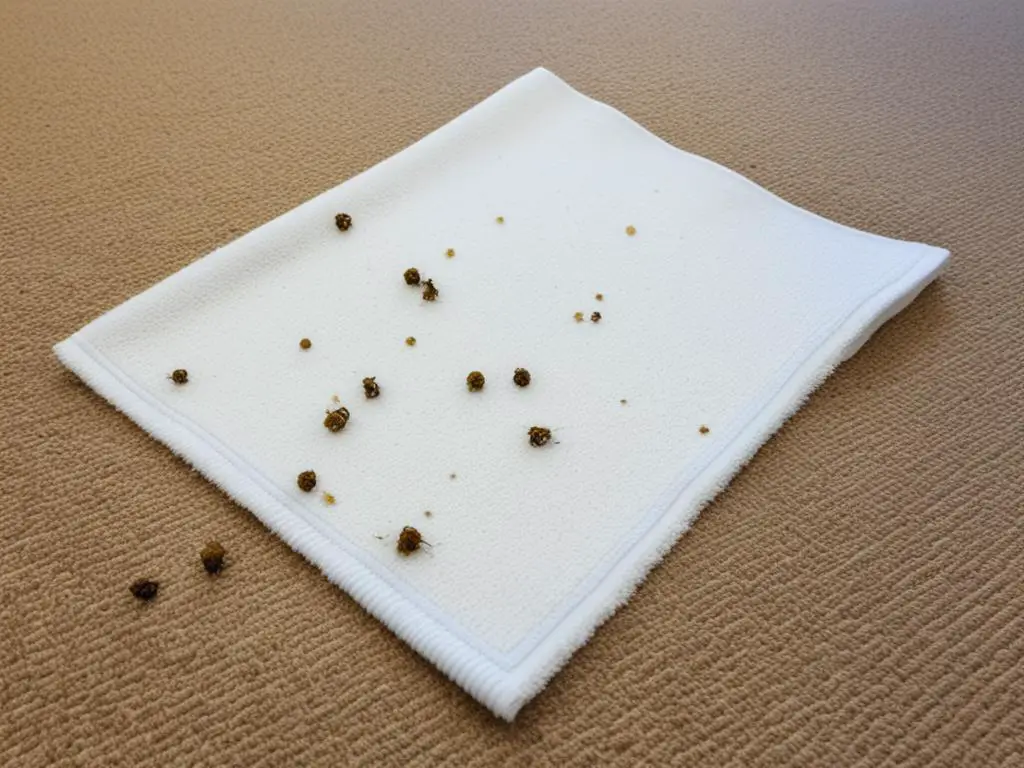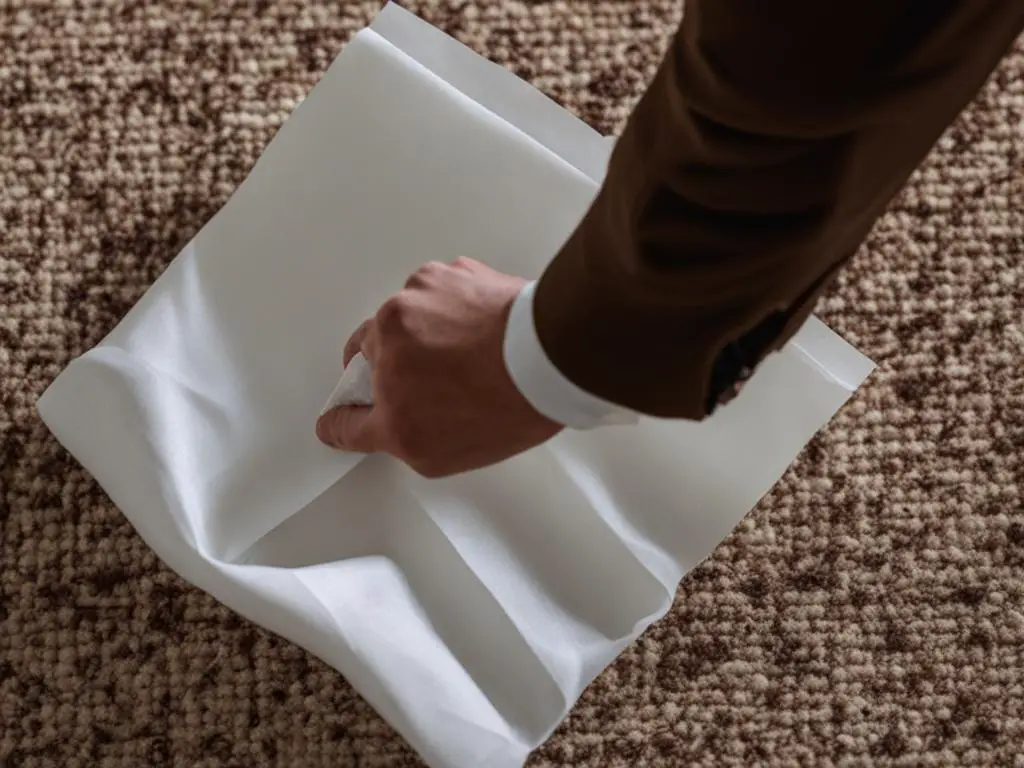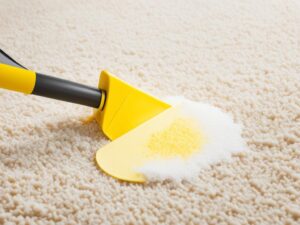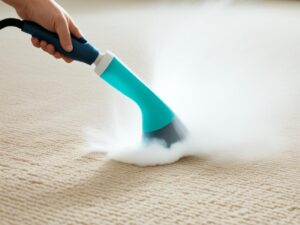Discovering mouse poop on your carpet can be unpleasant, but with the right approach, you can effectively clean it up and maintain a clean and safe home environment. Whether you’re dealing with a minor incident or a larger infestation, taking the necessary steps to remove the mouse droppings is essential for your health and peace of mind.
When cleaning up mouse poop on your carpet, it’s important to prioritize safety. Remember to wear protective gloves to avoid direct contact with the droppings and prevent the spread of any potential diseases. This simple precautionary measure will ensure that you stay safe throughout the cleaning process.
To begin the cleaning process, you’ll need a disinfectant or bleach solution. Dampen the mouse droppings with the solution, allowing it to thoroughly soak in. This will help disinfect the area and make it easier to remove the droppings. Use paper towels or disposable cleaning cloths to wipe up the moistened droppings, starting from the outer edges and working your way towards the center.
After successfully removing the mouse droppings, it’s important to properly dispose of the waste. Place the soiled paper towels or disposable cleaning cloths in a plastic bag and securely tie it to prevent any potential contamination. Be sure to dispose of the bag in a covered garbage can or follow your local waste management guidelines for proper disposal.
In addition to cleaning the affected area, it’s essential to thoroughly disinfect both the carpet and hard surfaces surrounding it. A mild bleach solution or a disinfectant specifically designed for rodent droppings cleanup can be used to disinfect the carpet. It’s recommended to follow the manufacturer’s instructions and use caution to avoid damaging the carpet fibers.
Furthermore, it’s important to clean and disinfect any other affected surfaces, such as baseboards or furniture that may have come into contact with the mouse droppings. This will help prevent any potential contamination and ensure a thorough cleaning process.
Remember to wash your hands thoroughly with soap and water or use a hand sanitizer after removing the gloves. This will help eliminate any lingering bacteria and maintain personal hygiene.
Key Takeaways:
- Wear protective gloves to avoid direct contact with mouse droppings.
- Use a disinfectant or bleach solution to wet the droppings before wiping them up with paper towels.
- Properly dispose of the waste by sealing it in a plastic bag and disposing of it in a covered garbage can.
- Thoroughly disinfect both the carpet and surrounding hard surfaces to prevent contamination.
- Wash your hands thoroughly after removing gloves to maintain personal hygiene.
How to Clean up Rodent Urine and Droppings
Cleaning up rodent urine and droppings requires taking precautions to prevent the spread of bacteria and disease.
Start by wearing rubber or plastic gloves to protect yourself. Then, spray the urine and droppings with a bleach solution or EPA-registered disinfectant until very wet and let it soak for the recommended time.
Use paper towels to wipe up the urine or droppings and cleaning product, and dispose of them in a covered garbage can. Mop or sponge the area with a disinfectant to ensure thorough cleaning. Finally, wash your hands with soap and water or a disinfectant after removing gloves.
Steps to Clean up Rodent Urine and Droppings
- Wear rubber or plastic gloves
- Spray the urine and droppings with a bleach solution or EPA-registered disinfectant until very wet
- Let it soak for the recommended time
- Use paper towels to wipe up the urine or droppings and cleaning product
- Dispose of them in a covered garbage can
- Mop or sponge the area with a disinfectant to ensure thorough cleaning
- Wash your hands with soap and water or a disinfectant after removing gloves
Properly cleaning up rodent urine and droppings helps eliminate mouse feces and ensures a clean and hygienic home environment. Taking these steps not only removes the visible signs of rodent activity but also helps in disinfecting the carpet and preventing the spread of bacteria and diseases.
Here is an image related to rodent droppings cleanup:

How to Clean up Dead Rodents or Rodent Nests
Dealing with dead rodents or rodent nests requires caution to prevent flea bites, diseases, and further contamination. Follow these steps to safely clean up the area:
- Put on rubber or plastic gloves to protect yourself from direct contact.
- Spray a disinfectant onto the dead rodent, nest, and the surrounding area. Ensure the area is fully saturated with the disinfectant.
- Allow the disinfectant to soak for the recommended amount of time to effectively kill any potential bacteria or pathogens.
- Using gloves, carefully pick up the dead rodent or nesting materials and place them in a plastic bag.
- Tie the bag tightly and dispose of it in a covered garbage can. Alternatively, check your state health department’s guidelines on safe disposal methods.
- After removing the gloves, thoroughly wash your hands with soap and water or use a suitable disinfectant.
Remember, proper cleaning not only removes the physical debris but also helps prevent the spread of diseases and ensures a safe environment.
Properly disposing of dead rodents or nests is essential to maintain a safe and clean living space.

Cautionary Measures:
When dealing with dead rodents or rodent nests, it’s important to take extra precautions to protect yourself. Here are a few additional tips:
- Avoid direct skin contact with the dead rodents as they may carry fleas or other parasites.
- Make sure to wear gloves that cover your hands completely.
- Use a high-quality disinfectant specifically designed for rodent cleanup to ensure effective sanitization.
- Do not use a vacuum cleaner to clean up the debris as it can spread harmful particles into the air.
- Always wash your hands thoroughly with soap and water, or use a suitable hand sanitizer, after removing the gloves.
Cleaning and Disinfecting Different Types of Surfaces
When it comes to cleaning and disinfecting different types of surfaces, it’s crucial to use the appropriate methods to ensure a thorough and effective cleaning process. Whether you’re dealing with hard surfaces, carpets, upholstery, or non-washable items, following specific recommendations will help eliminate rodent droppings, sanitize the area, and remove any lingering odors.
Hard Surfaces:
For hard surfaces like floors, countertops, cabinets, and drawers, begin by removing any visible rodent droppings. Then, use a disinfectant solution to clean and disinfect thoroughly. Pay attention to high-touch areas and surfaces that may have been contaminated.
Carpets and Upholstery:
When it comes to cleaning carpets and upholstery, it’s essential to use carpet cleaning solutions specifically designed for odor removal and disinfection. Consider using a commercial disinfectant spray or a steam cleaner to effectively remove rodent droppings and sanitize the area. Consult professional carpet cleaning services for deep-cleaning treatments, especially in severe infestation cases.
Non-Washable Items:
For non-washable items like books and papers that may have been affected by rodent droppings, it’s best to leave them outdoors in the sunlight or in a rodent-free area for several weeks. This exposure to the elements will help naturally eliminate any bacteria or odors. Alternatively, consult with professionals who specialize in document recovery and restoration, if needed.
Proper Disposal:
Dispose of any contaminated materials and waste, such as gloves, paper towels, or insulation, in sealed plastic bags. Place these bags in covered garbage cans to prevent any potential reinfestation. Follow local regulations and guidelines for safe disposal.
Remember, each type of surface requires specific cleaning and disinfection methods. By following these recommendations, you can effectively eliminate rodent droppings, disinfect the area, and ensure a clean and odor-free environment.

Cleaning and Disinfecting Vehicles
Vehicles can also be affected by rodent infestations, and it’s crucial to clean and disinfect them properly. Before starting the cleaning process, ventilate the vehicle by opening the doors and trunk for fresh air circulation. Inspect the vehicle for rodent activity, including droppings, nests, and dead rodents.
Use a disinfectant to spray the affected areas and let it sit for the recommended time. Pick up the droppings and dispose of them in a plastic bag, and clean the rest of the area with additional disinfectant. Reconnect the battery and wash your hands thoroughly after cleaning.
| Steps to Clean and Disinfect a Vehicle |
|---|
| Ventilate the vehicle by opening doors and trunk |
| Inspect for rodent activity (droppings, nests, dead rodents) |
| Spray affected areas with a disinfectant |
| Let disinfectant sit for recommended time |
| Pick up droppings and dispose of them in a plastic bag |
| Clean the rest of the area with additional disinfectant |
| Reconnect the battery |
| Wash hands thoroughly after cleaning |
Safe Methods for Cleaning Mouse Droppings from Carpets
When it comes to cleaning mouse droppings from carpets, it’s important to follow safe and effective methods. Here are some steps you can take to ensure proper cleaning and disinfection:
Air Out the Area
Before you begin cleaning, open windows and doors to ensure proper ventilation. This helps prevent the spread of any airborne particles.
Wear Protective Gloves
Always wear gloves to protect your hands from any potential diseases or contaminants present in the mouse droppings.
Avoid Sweeping or Vacuuming
Avoid sweeping or vacuuming the droppings, as this can release dust particles into the air. Instead, choose a damp cleaning method.
Dampen the Droppings
Dampen the droppings with a disinfectant or bleach solution. Let it soak for at least five minutes to ensure thorough disinfection.
Pick up the Droppings
Use paper towels to pick up the dampened droppings. Dispose of them in a plastic bag to prevent any further contamination.
Clean and Disinfect the Carpet
After removing the droppings, clean and disinfect the carpet using a commercial disinfectant or a steam cleaner. This will help eliminate any remaining bacteria or odor.
| Safe Methods for Cleaning Mouse Droppings from Carpets | |
|---|---|
| 1. Air out the area | Ensure proper ventilation by opening windows and doors. |
| 2. Wear protective gloves | Always wear gloves to protect your hands from potential diseases. |
| 3. Avoid sweeping or vacuuming | Choose a damp cleaning method instead to prevent the release of dust particles. |
| 4. Dampen the droppings | Use a disinfectant or bleach solution to dampen the droppings and let it soak for at least five minutes. |
| 5. Pick up the droppings | Use paper towels to pick up the dampened droppings and dispose of them in a plastic bag. |
| 6. Clean and disinfect the carpet | Use a commercial disinfectant or a steam cleaner to clean and disinfect the carpet. |
Conclusion
Cleaning up mouse poop on your carpet is an essential task to maintain a clean and safe home environment. By following proper precautions and using the right techniques, you can effectively remove mouse feces and eliminate potential health risks.
When dealing with mouse droppings, always remember to wear gloves to protect yourself from any harmful bacteria. Use a disinfectant or bleach solution to wet the droppings before wiping them up with paper towels. It’s important to properly dispose of the waste in a sealed bag to prevent any further contamination.
In addition to cleaning the carpet, don’t forget to disinfect all hard surfaces in your home using a suitable disinfectant. Different types of surfaces may require specific cleaning methods, so it’s important to follow the recommended instructions to ensure thorough disinfection.
Whether it’s cleaning carpets, upholstery, or even vehicles, proper and regular cleaning is crucial to maintain a clean and hygienic living environment. By following these carpet cleaning tips and eliminating mouse feces promptly, you can ensure a safe and healthy home for you and your family.



